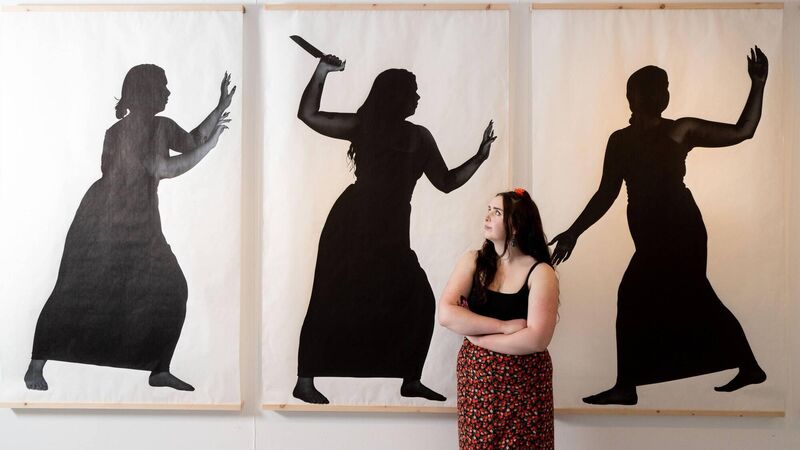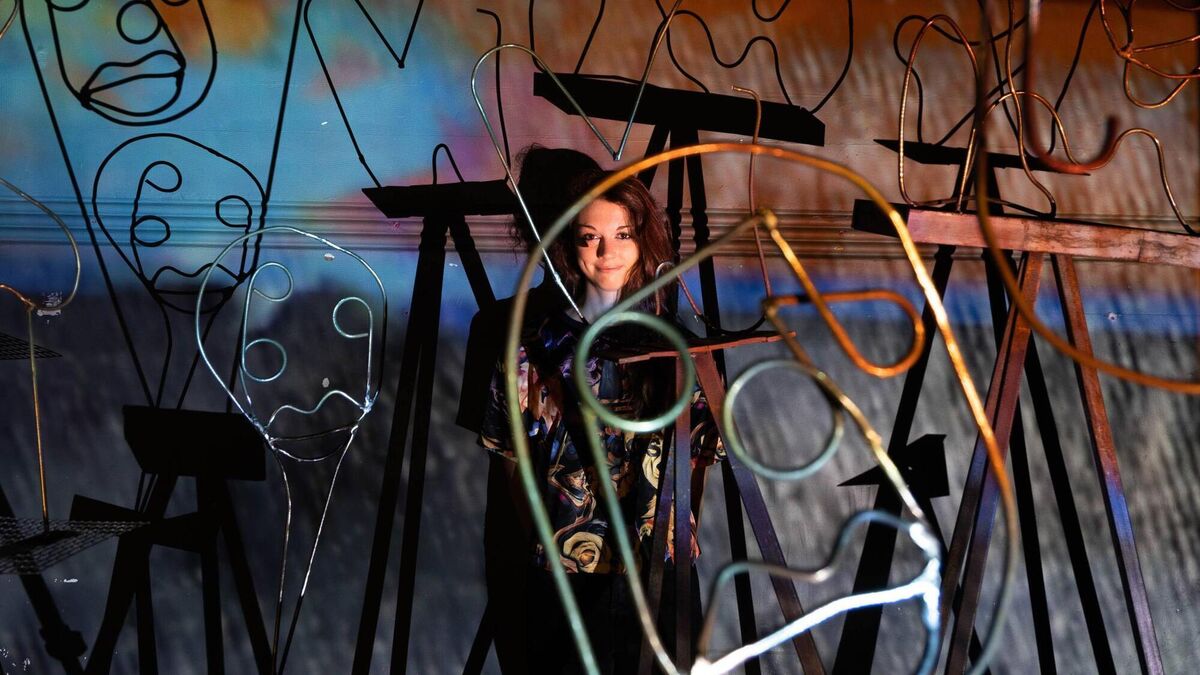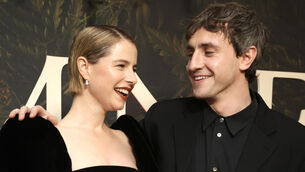'I’m interested in female mythology': Four students from the Crawford show explain their pieces

Nicola Sheehan with her series of self portraits MTU CCAD Degree Show titled Subject To Change. Picture: Darragh Kane
They chose to title their show Subject to Change, and it’s the students themselves that have been subject to a high level of change and uncertainty throughout their final year.
MTU Crawford College of Art and Design’s annual degree show, for graduating students, is the nail-biting culmination of their studies and the first time many of them will have exhibited work to the public.
To top it all off, this year’s crop of fourth year Fine Art and Applied Contemporary Art students faced extra challenges, having spent months during Covid-19 restrictions locked out of their studio spaces and trying to create work at home.
2021 is the second year running that Covid lockdowns have wreaked havoc on the students’ access to studio space and specialist equipment, but this year’s graduates, unlike last year’s, have been able to arrange a short physical exhibition at their Sharman Crawford St campus, as well as an online exhibition.
That 43 students managed to pull off a physical show having only gained access to their studios in March is itself a testament to their resilience and ingenuity, but the fact that the show has the overall level of accomplishment, professionalism and polish that it has makes the achievement doubly impressive.
Sheehan, from Bishopstown, embarked on a series of printmaking experiments whilst at home during lockdown, going viral on TikTok in the process.
Sheehan created life-size cyanotypes (an early form of photography using photosensitive chemicals) of herself on cotton fabric in her family’s back garden in April, before lockdown restrictions were lifted. One video she posted to the social media platform has garnered 2.4 million views, while others have hundreds of thousands.
“It’s good to document your process, but I couldn’t take pictures myself because I couldn’t move, so I had my brother take a few pictures and I did a TikTok of the process because it really looks like magic,” Sheehan says. “I really like watching videos of printmaking processes, but it turned out that there are a lot more out there like me that are equally fascinated.”
Sheehan’s exhibition displays her cyanotypes alongside life-size prints of digital self-portraits on Japanese Awagami paper to reimagine the Greek mythological figure of Helen of Troy, not as a hapless victim or scheming harridan, but as a woman with agency and purpose.
“I’m interested in female mythology and how women are depicted, sometimes unfairly,” she says. “I made self-portraits using images inspired by Athenian vases. There’s controversy over whether she’s running away in these images or whether she’s fighting, so I just wanted to tell her story in a more accurate way.”
Sheehan’s work has been purchased by the MTU art collection, Cork City Council Arts Office purchase prize and the Tyndall Institute.

Deirdre Coffey is a Fine Art graduate from Cappoquin in Co Waterford, who is now based in Cork city.
Her multimedia installation combines metal sculpture with projected video and sound to unsettling effect: inspired by The Machine Stops, a short sci-fi story by EM Forster written in 1909 and flagged by many as predictive of last year’s lockdown and ensuing technological reliance, Coffey set out to depict a modern-day Plato’s Cave, where the shadows of her crowd of metal figures are more prominent than their forms.
“The Machine Stops is about humans in the future being all hooked up to a machine, and becoming so reliant on this machine,” Coffey says.
“My installation is about the ever-increasing media presence in our reality: we basically have technology on us all the time and it’s influencing our minds. There are three eyes on each of my sculptures; a third eye usually represents insight in a religious context, so I was playing with that idea. The idea is that insight is nearly lost with this overbearing media presence.”
Coffey has also drawn on her own experience of trying to communicate with friends during lockdown, to describe the two dimensional nature of online communications.
“You see lots of people on your phone, but it’s all 2D, so I was trying to capture that flatness,” she says. “I feel like everything we’re seeing is overprocessed and unoriginal.”
Coffey’s work received an MTU Art collection purchase prize and has been acquired for the MTU art collection.

Peggoty Ransley is originally from Cornwall, but her family moved to An Rinn near Dungarvan ten years ago.
She drew on her own experience of keeping rescue horses to reimagine the position of the equine form in art and art history: her life-size sculptures of horses are not the common representations familiar throughout visual art, of magnificent warhorses or romanticised mythological beasts, but of horses subjected to human whim, used and discarded.
“While I was making this work, I was thinking about horses as animals that can be hugely prized and valuable one moment, and discarded the next,” Ransley says.
Ransley’s sculptures are made from 6mm steel bars and materials including horse-hair, mud, hay and farm plastics.
One sculpture in particular depicts a horse suspended, with ropes around its legs. It’s inspired by the story of one of her own rescue horses.
“One of my horses was left in a field to starve and they had to drag him out with a tractor, by tying rope around his legs,” Ransley says. “He was one and a half when this happened, and we’ve had him eight years.
“He’s called Harley, and he’s the funniest horse. Because he was quite young when we rescued him, he acts a bit like a dog and follows you around. He’s quite a character.”
Ransley is in receipt of a Crawford Graduate Residency Award in sculpture.

Maitiú MacCárthaigh comes from Ballinascarthy in West Cork. He delves into his farming background to explore Irish relationships to agricultural land, inheritance practices and the environmental pressures modern farming practices are creating.
“I grew up on a farm, as a son that was set to inherit, but the farm burned down when I was very young,” MacCárthaigh says. “Growing up and realising I was gay, I felt alienated from, or at unease with, the heteronormative ideals of agricultural work.”
MacCárthaigh grew potatoes in bags made from his prints, screen-printed large photographic images of farm buildings, both renovated and derelict, onto large tarpaulins, and even invented a new process which he has dubbed the “créograph”, from the Irish “cré” for earth, for a screen-printed self-portrait he produced using earth.
MacCárthaigh was aware of news reports of murder-suicides with a link to farming inheritance while he was making the work.
“It’s horrifying but I think it’s still an accepted culture in a way, the idea that disputes between family members and loved ones happen all the time and can have these atrocious outcomes,” he says. “My work is not a way of trying to push back politically against this, more just a personal conversation with agriculture in Ireland as this old, dying process that needs to be changed for several reasons, including family disputes, failing crops, failing futures, and how that can be reborn in a new sense of Irishness and in queer space.”
MacCárthaigh received the MTU President’s Prize for outstanding studentship and the college’s own Thesis prize.
- MTU Crawford College of Art and Design’s degree show 2021, Subject to Change, is open to the public from 11am to 7pm on Tuesday the 15th of June, and is available online.




